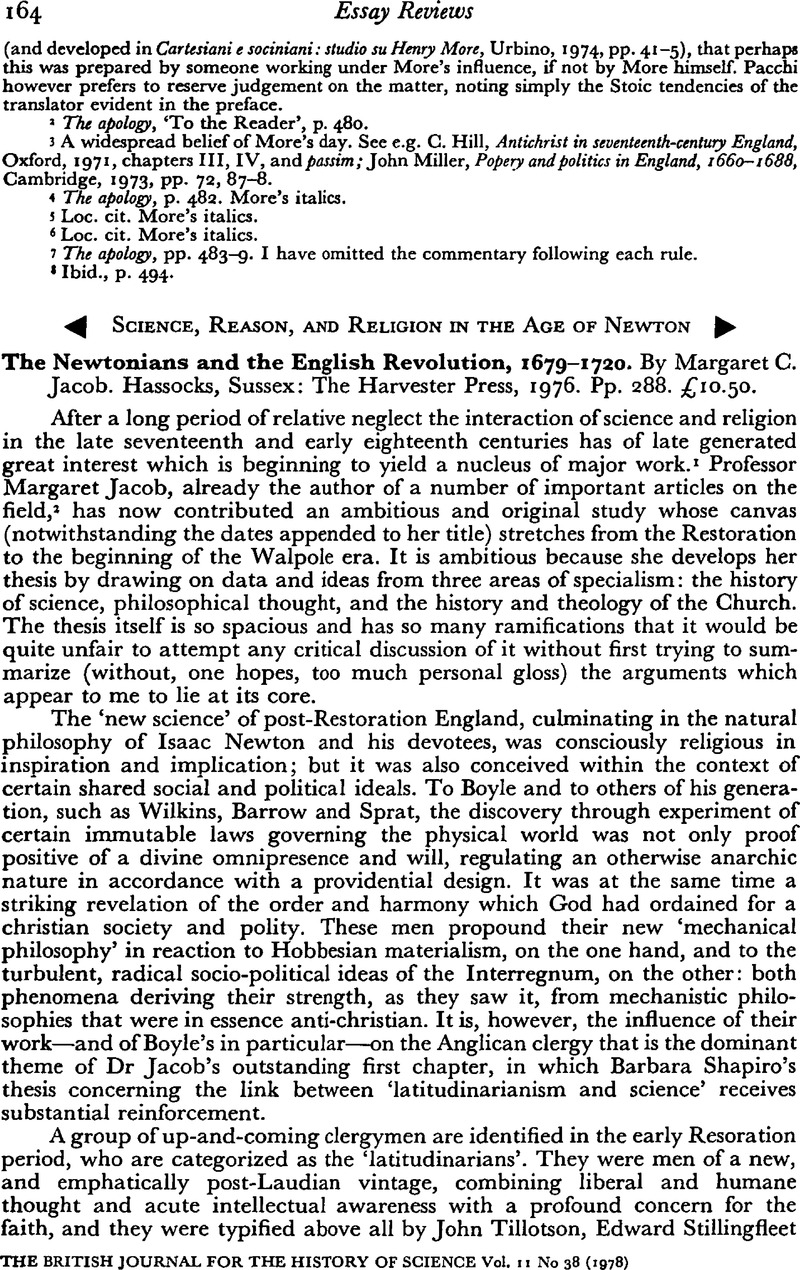Article contents
Science, Reason, and Religion in the Age of Newton
Published online by Cambridge University Press: 05 January 2009
Abstract

- Type
- Essay Reviews
- Information
- Copyright
- Copyright © British Society for the History of Science 1978
References
NOTES
1 Over the period 1968–1976, for example: Shapiro, B. J., ‘Latitudinarianism and science in seventeenth-century England’, Past and present, 1968, 40CrossRefGoogle Scholar; John Wilkins, 1614–1672: an intellectual biography, Berkeley, 1969Google Scholar; Dahm, J. J., ‘Science and aplogetics in the early Boyle Lectures’, Church history, 1970, 39CrossRefGoogle Scholar; Austin, W. H., ‘Isaac Newton on science and religion’, Journal of the history of ideas, 1970, 31CrossRefGoogle Scholar; Jacob, J. R., ‘Robert Boyle and subversive religion in the early Restoration’, Albion, 1974, 6CrossRefGoogle Scholar; Manuel, F. E., The religion of Isaac Newton, Oxford, 1974Google Scholar; Redwood, J., Reason, ridicule and religion: the age of enlightenment in England, 1660–1750, London, 1976.Google Scholar
2 Jacob, M. C., ‘John Toland and the Newtonian ideology’, Journal of the Warburg and Courtauld Institutes, 1969, 32CrossRefGoogle Scholar; ‘The Church and the formulation of the Newtonian world-view’, Journal of European studies, 1971, 1Google Scholar; Jacob, M. C. and Lockwood, W. A., ‘Political millenarianism and Burnet's Sacred theory’, Science Studies, 1972, 2.CrossRefGoogle Scholar
3 Op. cit., pp. 12, 14–15, 19–20, 29, 220–2.Google Scholar
4 Birch, Thomas (ed.), Works of the Honourable Robert Boyle, London, 1744, i, 105–6.Google Scholar
5 See Dickson, P. G. M., The financial revolution in England: a study in the development of public credit, 1688–1756, London 1967Google Scholar; Speck, W. A., ‘Conflict in society’, in Holmes, G. (ed.), Britain after the Glorious Revolution, 1689–1714, London, 1969.Google Scholar
6 Speck, , loc. cit. (5), pp. 144–5.Google Scholar The three turning-points were the cutting by half of the Land Tax (a burden largely evaded by the monied interest) in 1713, the much-reduced dependence of the government on loans once the wars were over, and the collapse of the South Sea Bubble.
7 Holmes, G.British politics in the age of Anne, London, 1967, pp. 28–30, 167–170, 172–4.Google Scholar
8 See, e.g., Holmes, G., ‘The Sacheverell riots: the crowd and the Church in early eighteenth-century London’, Past and present, 1976, 72, 61–4.CrossRefGoogle Scholar
9 Especially Bennett, G. V., The Tory crisis in Church and State, 1688–1730, Oxford, 1975Google Scholar; Holmes, G., The trial of Doctor Sacheverell, London, 1973.Google Scholar
10 Bennett, G. V., ‘King William III and the episcopate’, in Bennett, G. V. and Walsh, J. D. (eds.), Essays in modern English church history, London, 1966Google Scholar; ‘Robert Harley the Godolphin ministry and the bishoprics crisis of 1707’ English historical review, 1967, 82Google Scholar; Sykes, N., ‘Queen Anne and the episcopate’, English historical review, 1935, 50.Google Scholar
11 Bennett, , ‘King William III and the episcopate’, op. cit. (10), pp. 122–3.Google Scholar See also the sources cited in ibid. p. 123, n.1.
12 Evelyn considered his second lecture, 4 April 1692, ‘one of the most noble, learned, and convincing discourses that I had ever heard’; de Beer, E. S. (ed.), The diary of John Evelyn, Oxford, 1955, v, 94.Google Scholar See also ibid. p. 123.
13 Holmes, , Trial of Doctor Sacheverell, op. cit. (9), pp. 42–3.Google Scholar
14 Nicolson's diaries, the originals of which are in Tullie House, Carlisle, are being edited for publication by the reviewer and Mr Clyve Jones.
15 Redwood, , op. cit. (1), pp. 169–70Google Scholar; McLachlan, H. J., Socinianism in seventeenth-century England, Oxford, 1951, pp. 4–6, 96–102, 325–37, and passim.Google Scholar
16 Although Nye was strictly a Sabellian he was frequently labelled a Socinian, a term which in the: 1690s was being loosely interpreted. For Nye's views, writings, and influence see McLachlan, , op. cit. (15), pp. 294, 297n., 315, and especially pp. 320–3.Google Scholar
17 Historical Manuscripts Commission, Bath MSS., i, 52–4: Robert Harley to Archbishop Tenison (draft), 11 August 1702.
18 Lloyd-Baker-Sharp MSS: Bishop Wm. Lloyd to Archbishop Sharp, 4 May 1709; Christ Church, Oxford, Wake MSS: Bishop Wm. Wake to Clarke, 4 July 1714. In general, see Bennett, , Tory crisis, op. cit. (9), pp. 135–6Google Scholar; Sykes, N., William Wake, Archbishop of Canterbury, Cambridge, 1957; ii 154–9Google Scholar; and the excellent brief treatment of both Whiston's and Clarke's thinking on the Trinity, and the shock and ostracism it provoked, in Redwood, , op. cit. (1), pp. 165–9.Google Scholar
- 9
- Cited by


